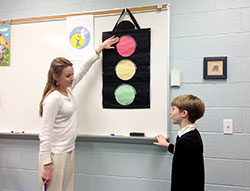Circle of Grace teaches children their safe boundaries

As part of the archdiocese’s Circle of Grace program, Amy Shields uses a stoplight to explain to children how they should approach safe and unsafe touching. For example, if a parent hugs a child, that’s a green light situation (it’s OK for the child to hug back because the child is comfortable with the person.) If a friend at school hugs a child, it may be a yellow light situation (if the child is comfortable, then the hug is fine. If the child doesn’t want a hug, it’s not.) If a stranger were to hug a child, it would be a red light situation where the child would need to tell a trusted adult. A kindergarten catechism teacher at St. Paul Parish in Tell City, Shields explains the concept to her son, Griffin. (Submitted photo)
By Michaela Raffin
Kindergarten students in the Catholic school raise their arms over their heads, form a circle, and bring the circle down around their bodies. The children are being taught that this is their “Circle of Grace,” a personal space given to them by God that others may not violate without permission.
This activity is part of the Circle of Grace religious education program that is being implemented in schools and parishes throughout the archdiocese. The program is designed to educate children and youths about the value of positive relationships, and protecting themselves from negative ones.
“The program empowers children to understand their sacredness, and gives them the skills and language to protect themselves in situations that might be risky,” said Providence Sister Cathy Campbell, coordinator of the Circle of Grace program for the archdiocese.
“Children have to be able to recognize who they are in the eyes of God, and then to be able to protect themselves by knowing what are safe boundaries and unsafe boundaries.”
Circle of Grace is a direct response to the U.S. Conference of Catholic Bishops’ “Charter for the Protection of Children and Young People.” The curriculum combines safety tips and relationship building with the teachings of the Catholic faith. It is meant to be taught in conjunction with parish schools and religious education curricula.
Circle of Grace has become an integral part of the Tell City Deanery’s religious education program. Benedictine Sister Mary Emma Jochum is the director of faith formation at St. Paul Parish in Tell City. She has been helping her catechism teachers familiarize themselves with the lessons.
“Walking through the lessons with each grade-level catechist helped them understand that there is a lot that the kids need to know and understand when it comes to safe and unsafe secrets, safe and unsafe adults,” Sister Mary Emma said. “The kids now realize that there are adults you can go to, and adults that are not safe to go to.”
Each Circle of Grace lesson is designed to build upon the previous one. Wherever children encounter the program, they learn some key concept about the Circle of Grace.
“On the sixth-grade level, we teach the girls about really appreciating their individuality, and we teach them about appreciating who they are and loving that about themselves,” said Cindy Ehrlich, a sixth-grade catechism teacher at St. Paul Parish. “We try to show them that their differences are a good thing, and that’s who God intended them to be. You can just see from the beginning to the end how much they like that.”
Lessons cover a variety of topics, such as positive self-image, Internet and social media safety, and relationship building with trusted adults. Each lesson is tailored to the appropriate age group. The program has received positive feedback from children, parents and teachers.
“Some of my teachers say they get better interaction with the kids teaching Circle of Grace than they do with the religion textbook,” said Sister Mary Emma. “I think it’s because they’re a little bit more knowledgeable about what we’re talking about.”
Circle of Grace has also been successful in archdiocesan Catholic schools. Yolanda McCormick, principal of St. Lawrence School in Indianapolis, believes the program fits in well with her school’s existing religion curriculum.
“The teachers have found it to be useful and user friendly, and it serves its purpose,” she said. “I’ve encouraged the teachers to find a way to incorporate it with other religion lessons.”
While adhering and relating to Catholic teachings, Circle of Grace highlights important issues that children face today with digital and personal relationships.
“In this day and age, with so many issues out there in the world, the more knowledge the kids have about it, the better they are,” said McCormick. “I think it’s a step in the right direction to prepare our children for the future and for the present as well.”
At the core of the Circle of Grace curriculum is the idea of personal relationships, healthy boundaries and God’s unending love.
“The whole thing is a sense of how very close God is to us, and how he has provided us this environment of grace that no one has a right to violate without our permission,” Sister Cathy said. “And if we’re well-informed, we will not give them that permission because we know what a healthy boundary is, and we know that God loves us and God wants us to be loved and to be safe.” †
